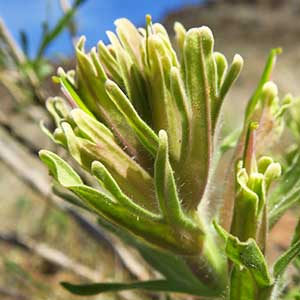Castilleja xanthotricha
Castilleja latifolia
John Day or yellow-hairy paintbrush, John Day paintbrush, yellow hair paintbrush, yellow-hair Indian paintbrush
Monterey coast paintbrush, Monterey Indian paintbrush, Monterey paintbrush, seaside paintbrush
few to several, ± decumbent to erect or ascending, unbranched, sometimes with short, leafy axillary shoots, hairs erect to spreading, long, soft, eglandular, mixed with short stipitate-glandular ones.
many, spreading to erect, much-branched, with numerous short, leafy axillary shoots, hairs moderately dense, spreading, medium length to long, stiff to soft, shorter stipitate-glandular ones.
green, linear, lanceolate to broadly lanceolate, oblong, or cuneate, 0.8–5 cm, not fleshy, margins plane to wavy, involute, 0–5-lobed, apex acute, sometimes rounded;
lobes spreading, linear, arising below mid length, nearly as broad as center lobe, apex acute.
gray-green becoming ± purple to sometimes green as hairs are lost, oblong to lanceolate-oblong or broadly lanceolate, 0.5–2 cm, ± fleshy, cupulate, sometimes obscurely so on distal portion of stem, margins plane, sometimes ± wavy, involute, 0–3-lobed, apex truncate or broadly rounded to obtuse;
lobes erect to ascending, oblong, apex rounded.
3–14 × 1.5–4.5 cm;
bracts proximally greenish, rarely dull reddish purple, distally white to cream, rarely pale yellow or dull, pale pink (sharply differentiated from proximal coloration), lanceolate or oblong to narrowly ovate, (3–)5–7-lobed;
lobes ascending, linear to obovate, ± broadened distally, medium, long, proximal lobes arising below mid length, central lobe apex broadly rounded to truncate, others acute to rounded.
2.5–20 × 1.5–5 cm;
bracts proximally green to dull, deep brownish purple, distally bright red, red-orange, or orange, sometimes yellow to yellow-orange, oblong or broadly lanceolate to widely obovate or ovate, often cup-shaped, center lobe often expanded distally, 0–3(–5)-lobed, often wavy-margined;
lobes ascending, oblong, short or long, arising near or above mid length, central lobe apex mostly rounded to truncate, sometimes with 5 or so very shallow teeth.
curved, 17–23 mm;
tube 15–19 mm;
beak exserted, adaxially green, 5–8(–9) mm, puberulent, stipitate-glandular;
abaxial lip deep purple (color sometimes visible through calyx), green, pinkish, or pale yellow, ± prominent, slightly inflated, usually hidden in calyx, sometimes right at top of calyx, 2 mm, ca. 50% as long as beak;
teeth ascending, whitish, yellowish, pink, or green, 1–1.5 mm.
slightly curved, 19–30 mm;
tube 8.5–15 mm;
beak exserted, adaxially green, 8.5–15 mm;
abaxial lip ascending, deep green, reduced, 0.5–1 mm, 5–10% as long as beak;
teeth incurved, reduced, green or white, 0.2–0.5 mm.
colored as bracts, 15–26 mm;
abaxial and adaxial clefts 3.5–7 mm, 25–50% of calyx length, deeper than laterals, lateral 2–5 mm, 12–25% of calyx length;
lobes linear, oblong, or narrowly triangular, center lobe apex usually rounded, lobes acute to rounded.
proximally light green to sometimes purple, distally colored as bracts, 15–25 mm;
abaxial and adaxial clefts 6–9.5 mm, 33–50% of calyx length, deeper than laterals, lateral 1–3 mm, ca. 12% of calyx length;
lobes broadly triangular to oblong, apex rounded to obtuse, rarely acute.
= 48.
= 24.
Castilleja xanthotricha
Castilleja latifolia
Castilleja xanthotricha is endemic to moderate elevations in the sagebrush hills of the John Day River drainage in north-central Oregon. N. H. Holmgren (1971) hypothesized that this tetraploid species is of allopolyploid hybrid origin between C. glandulifera and C. oresbia.
(Discussion copyrighted by Flora of North America; reprinted with permission.)
Castilleja latifolia is endemic to the central California coast, especially around Monterey Bay. Around Half Moon Bay in San Mateo County, it apparently forms hybrids with C. affinis var. affinis. Records of this species from north of San Francisco and south of Monterey County are referable to other species.
(Discussion copyrighted by Flora of North America; reprinted with permission.)
